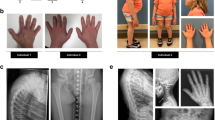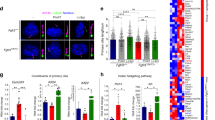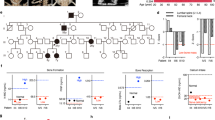Abstract
The longitudinal growth of the skeleton arises from the continuous process of endochondral ossification occurring at the ends of growing long bones. Dwarfism results when this process is disrupted, as in the autosomal dominant human skeletal diseases hypochondroplasia (HCH)1, achondroplasia (ACH)2 and thanatophoric dys-plasia (TD)3. Interestingly, these disorders display a graded spectrum of phenotypic severity and are the result of distinct missense mutations in the fibroblast growth factor receptor 3 gene (FGFR3). TD, characterized by neonatal lethality and profound dwarfism, is the result of FGFR3 mutations, including an R248C substitution in the extracellular domain or a K650E substitution in the tyrosine kinase (TK) domain4. ACH, which is non-lethal and presents less severe dwarfism, results almost exclusively from a G380R substitution in the transmembrane domain5, 6. Homozy-gous achondroplasia resembles the phenotype of TD7. In this report the effect of the ACH and TD mutations on the activity and regulation of FGFR3 are analysed. We showed that each of the mutations constitutively activate the receptor, as evidenced by ligand-independent receptor tyro-sine phosphorylation and cell proliferation. Moreover, the mutations that are responsible for TD were more strongly activating than the mutation causing ACH, providing a biochemical explanation for the observation that the phenotype of TD is more severe than that of ACH
This is a preview of subscription content, access via your institution
Access options
Subscribe to this journal
Receive 12 print issues and online access
$209.00 per year
only $17.42 per issue
Buy this article
- Purchase on Springer Link
- Instant access to full article PDF
Prices may be subject to local taxes which are calculated during checkout
Similar content being viewed by others
References
Oberklaid, R., Danks, D.M., Jensen, F., Stace, L. & Rosshandler, S. Achondroplasia and hypochondroplasia. Comments on frequencey, mutation rate, and radiological features in skull and spine. J. Med. Genet. 16, 140–146 (1979).
Briner, J., Giedion, A. & Spycher, M.A. Variation of quantitative and qualitative changes of enchondral ossification in heterozygous achondroplasia. Pathol. Res. Pract. 187, 271–278 (1991).
Shah, K., Astley, R. & Cameron, A.H. Thanatophoric dwarfism. J. Med. Genet. 10, 243–252 (1973).
Tavormina, P.L. et al.Thanatophoric dysplasia (types I and II) caused by distinct mutations in fibroblast growth factor receptor 3. Nature Genet. 9, 321–328 (1995).
Rousseau, F. et al. Mutations in the gene encoding fibroblast growth factor receptor-3 in achondroplasia. Nature 371, 252–254 (1994).
Shiang, R. et al. Mutations in the transmembrane domain of FGFRS cause the most common genetic form of dwarfism, achondroplasia. Cell 78, 335–342 (1994).
Rimoin, D.L. & Lachman, R.S. Genetic disorders of the osseous skeleton, in McKusick's Heritable Disorders of connective tissue. (ed. Beighton, R) 557–689 (Mosby-Year Book, St. Louis, 1993).
Ornitz, D.M., Yayon, A., Flanagan, J.G., Svahn, C.M., Levi, E. & Leder, P. Heparin is required for cell-free binding of basic fibroblast growth factor to a soluble receptor and for mitogenesis in whole cells. Mol. Cell. Biol. 12, 240–247 (1992).
Ornitz, D.M. & Leder, P. Ligand specificity and heparin dependence of fibroblast growth factor receptors 1 and 3. J. Biol. Chem. 267, 16305–16311 (1992).
Chellaiah, A.T., McEwen, D.G., Werner, S., Xu, J. & Ornitz, D.M. Fibroblast Growth Factor Receptor (FGFR) 3: Alternative splicing in immunoglobulin-like domain III creates a receptor highly specific for acidic FGF/FGF-1. J. Biol. Chem. 269, 11620–11627 (1994).
Keegan, K., Meyer, S. & Hayman, M.J. Structural and biosynthetic characterization of the fibroblast growth factor receptor 3 (FGFR-3) protein. Oncogene 6, 2229–2236 (1991).
Bargmann, C.I., Hung, M.-C. & Weinberg, R.A. Multiple independent activations of the neu oncogene by a point mutation altering the transmembrane domain of p185. Cell 45, 649–657 (1986).
Neilson, K.M. & Friesel, R.E. Constitutive activation of fibroblast growth factor receptor-2 by a point mutation associated with Crouzon syndrome. J. Biol. Chem. 270, 26037–26040 (1995).
Santoro, M. et al. Activation of RET as a dominant transforming gene by germline mutatins of MEN2A and MEN2B. Science 267, 381–383 (1995).
Sorokin, A., Lemmon, M.A., Ullrich, A. & Schlessinger, J. Stabilization of an active dimeric form of the epidermal growth factor receptor by introduction of an inter-receptor disulfide bond. J. Biol. Chem. 269, 9752–9759 (1994).
Watowich, S.S., Hilton, D.J. & Lodish, H.F. Activation and inhibition of erythropoietin receptor function: Role of receptor dimerization. Mol. Cell. Biol. 14, 3535–3549 (1994).
Blechman, J.M. et al. The fourth immunoglobulin domain of the stem cell factor receptor couples ligand binding to signal transduction. Cell 80, 103–113 (1995).
De Vos, A.M., Ultscyh, M. & Kossiakoff, A.A. Human growth hormone and extracellular domain of its receptor: Crystal structure of the complex. Science 255, 306–312 (1992).
Muenke, M. & Schell, U. Fibroblast-growth-factor receptor mutations in human skeletal disorders. Trends. Genet. 11, 308–313 (1995).
Wilkie, A.O.M., Morriss-Kay, G.M., Jones, E.Y. & Heath, J.K. Functions of fibroblast growth factors and their receptors. Curr. Biol. 5, 500–507 (1995).
Mohammadi, M., Dikic, I., Sorokin, A., Burgess, W.H., Jaye, M. & Schlessinger, J. Identification of six novel autophosphorylation sites on fibroblast growth factor receptor 1 and elucidation of their importance in receptor activation and signal transduction. Mol. Cell. Biol. 16, 977–989 (1996).
Hanks, S.K., Quinn, A.M. & Hunter, T. The protein kinase family: conserved features and deduced phylogeny of the catalytic domains. Science 241, 42–52 (1988).
Formisano, P. et al. Mutation in a conserved motif next to the insulin receptor key autophosphorylation sites de-regulates kinase activity and impairs insulin action. J. Biol. Chem. 268, 5241–5248 (1993).
Hubbard, S.R., Wei, L., Ellis, L. & Hendrickson, W.A. Crystal structure of the tyrosine kinase domain of the human insulin receptor. Nature 372, 746–754 (1994).
Hanneken, A., Ying, W., Ling, N. & Baird, A. Identification of soluble forms of the fibroblast growth factor receptor in blood. Proc. Natl. Acad. Sci. USA 91, 9170–9174 (1994).
Rupp, R.A.W., Snider, L. & Weintraub, H. Xenopus embryos regulate the nuclear localization of XMyoD. Genes Dev. 8, 1311–1323 (1994).
Olwin, B.B. & Hauschka, S.D. Fibroblast growth factor receptor levels decrease during chick embryogenesis. J. Cell Biol. 110, 503–509 (1990).
Webster, M.K. & Donoghue, D.J Constitutive activation of fibroblast growth factor receptor 3 by the transmembrane domain point mutation found in achondroplasia. EMBO J. 15, 520–527 (1996).
Colvin, J.S., Bohne, B.A., Harding, G.W., McEwen, D.G. & Ornitz, D.M. Skeletal overgrowth and deafness in mice lacking fibroblast growth factor receptor 3. Nature Genet. 12, 390–397 (1996).
Deng, C., Wynshaw-Boris, A., Zhou, F., Kuo, A & Leder, P. Fibroblast growth factor receptor 3 is a negative regulator of bone growth. Cell 84, 911–921 (1996).
Author information
Authors and Affiliations
Rights and permissions
About this article
Cite this article
Naski, M., Wang, Q., Xu, J. et al. Graded activation of fibroblast growth factor receptor 3 by mutations causing achondroplasia and thanatophoric dysplasia. Nat Genet 13, 233–237 (1996). https://doi.org/10.1038/ng0696-233
Received:
Accepted:
Issue Date:
DOI: https://doi.org/10.1038/ng0696-233
This article is cited by
-
The spontaneous mouse mutant low set ears (Lse) is caused by tandem duplication of Fgf3 and Fgf4
Mammalian Genome (2023)
-
Prenatal trio-based whole exome sequencing in fetuses with abnormalities of the skeletal system
Molecular Genetics and Genomics (2022)
-
Fibroblast growth factor signalling in osteoarthritis and cartilage repair
Nature Reviews Rheumatology (2020)
-
Enhanced FGFR3 activity in postmitotic principal neurons during brain development results in cortical dysplasia and axonal tract abnormality
Scientific Reports (2020)
-
Achondroplasia: a comprehensive clinical review
Orphanet Journal of Rare Diseases (2019)



